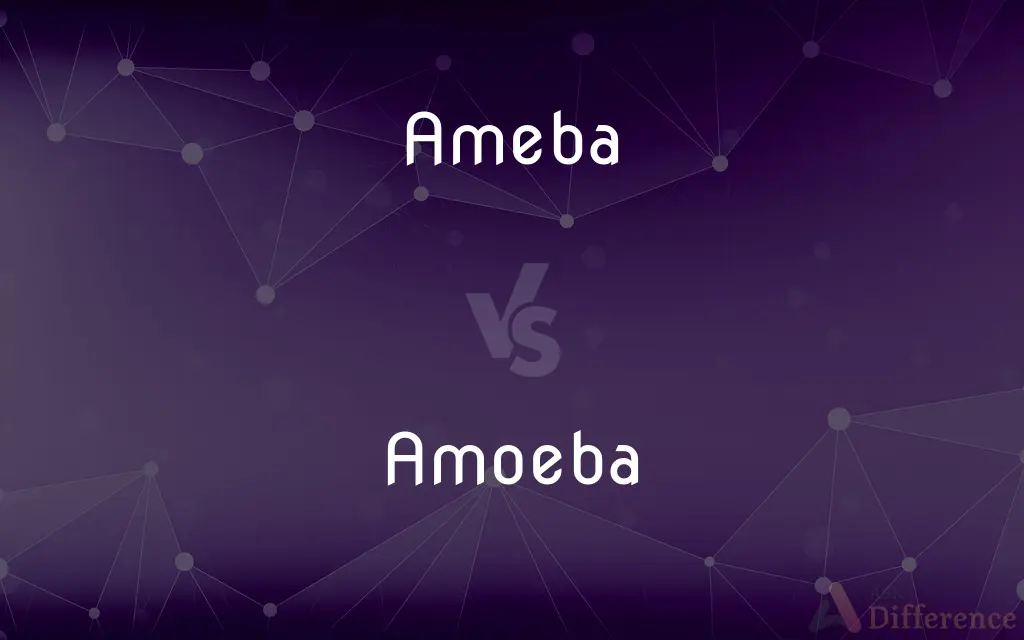Ameba vs. Amoeba — What's the Difference?
By Maham Liaqat & Urooj Arif — Updated on March 18, 2024
Ameba and amoeba refer to the same single-celled organism known for its shape-shifting abilities, with "ameba" being an alternative spelling often used in American English.

Difference Between Ameba and Amoeba
Table of Contents
ADVERTISEMENT
Key Differences
Both terms describe a type of single-celled protozoan that belongs to the group Amoebozoa. These organisms are characterized by their ability to change shape due to the extension and retraction of pseudopods, which also aid in movement and feeding. While "amoeba" is the more commonly used spelling internationally and in scientific contexts, "ameba" is an accepted variant in American English, reflecting a simplified approach to spelling.
In terms of morphology and behavior, there is no difference between an entity referred to as an "ameba" and one called an "amoeba." Both exhibit the classic traits of amoeboid organisms, such as a flexible cell membrane, the formation of pseudopodia for movement and feeding, and a life cycle that can include both free-living and parasitic species.
The spelling variation does not indicate any taxonomic, structural, or functional difference between the organisms. The choice between "ameba" and "amoeba" often comes down to regional spelling preferences or the context in which the term is being used, with scientific publications favoring "amoeba."
Both spellings are used in educational materials, with "amoeba" more likely to appear in international or scientific contexts, whereas "ameba" might be found in American textbooks or less formal American English writing. This reflects broader patterns in English spelling variations, such as "color" vs. "colour" or "center" vs. "centre."
Despite the spelling differences, the understanding and study of these organisms under either name cover the same biological characteristics and scientific significance. Amoebae are studied for their evolutionary biology, cellular processes, and in some cases, their roles in human disease, regardless of the spelling used.
ADVERTISEMENT
Comparison Chart
Definition
A single-celled, shape-shifting organism, variant spelling in American English
The common international spelling for a shape-shifting, single-celled organism
Usage
Preferred in American English contexts
Widely used in scientific and international contexts
Biological Characteristics
Identical to amoeba: flexible membrane, pseudopodia, etc.
Identical to ameba: flexible membrane, pseudopodia, etc.
Taxonomic Significance
No difference; purely a spelling variation
No difference; purely a spelling variation
Educational Context
May appear in American educational materials
Common in international educational and scientific materials
Compare with Definitions
Ameba
A single-celled organism known for its changing shape.
The ameba moved by extending its pseudopodia.
Amoeba
A protist characterized by its ability to alter shape.
The amoeba engulfed its food through phagocytosis.
Ameba
Can cause diseases in humans.
Entamoeba histolytica is a parasitic ameba causing dysentery.
Amoeba
Contributes to cell biology insights.
Amoeba studies have elucidated aspects of cellular movement.
Ameba
Studied for understanding basic cell processes.
Scientists use ameba to study cell motility.
Amoeba
Thrives in varied aquatic environments.
Many amoeba species are adaptable to different water conditions.
Ameba
Common in ponds and lakes.
Ameba proteus is often found in freshwater environments.
Amoeba
Certain species are harmful to humans.
Acanthamoeba keratitis, caused by an amoeba, affects the eyes.
Ameba
Primarily through binary fission.
Under favorable conditions, an ameba divides into two cells.
Amoeba
An amoeba (; less commonly spelt ameba or amœba; plural am(o)ebas or am(o)ebae ), often called an amoeboid, is a type of cell or unicellular organism which has the ability to alter its shape, primarily by extending and retracting pseudopods. Amoebae do not form a single taxonomic group; instead, they are found in every major lineage of eukaryotic organisms.
Ameba
Variant of amoeba.
Amoeba
Any of various one-celled free-living or parasitic protozoans having no definite form and moving by means of pseudopods.
Ameba
(American spelling) amoeba
Amoeba
(biology) A member of the genus Amoeba of unicellular protozoa that moves by means of temporary projections called pseudopodia.
Ameba
Naked freshwater or marine or parasitic protozoa that form temporary pseudopods for feeding and locomotion. Same as amoeba.
Amoeba
(mathematics) The graph of the real part of the logarithms of a polynomial equation in complex numbers.
Ameba
Naked freshwater or marine or parasitic protozoa that form temporary pseudopods for feeding and locomotion
Amoeba
A rhizopod common in fresh water, capable of undergoing many changes of form at will. Same as ameba. See Rhizopoda.
Amoeba
Naked freshwater or marine or parasitic protozoa that form temporary pseudopods for feeding and locomotion
Common Curiosities
Is one spelling more correct than the other?
Both spellings are correct, with "amoeba" being the preferred form in scientific literature and "ameba" commonly used in American English.
Why are there two spellings for amoeba?
The variation "ameba" reflects American English spelling preferences, similar to other words that have different spellings in American and British English.
Are ameba and amoeba two different organisms?
No, they refer to the same type of single-celled organisms, with the difference being purely in spelling.
How do amebae move?
Amebae move by extending and retracting pseudopods, which are temporary projections of their cell body.
Where can amebae be found?
Amebae can be found in a variety of environments, including freshwater ponds, lakes, soil, and in some cases, living as parasites in host organisms.
Are there beneficial amebae?
Yes, many amebae play important roles in their ecosystems, such as decomposing dead organic material and being part of the food chain.
Can all amebae cause disease?
No, while some amoebae are pathogenic to humans, many are harmless and are an essential part of their ecosystems.
Do amebae have a fixed shape?
No, one of the defining characteristics of amebae is their ability to change shape due to their flexible cell membrane and the formation of pseudopods.
Do amebae have any sensory organs?
Amebae do not have traditional sensory organs but can respond to chemical signals in their environment through receptors on their cell membrane.
Are there any cultural or historical significances associated with amebae?
While not culturally significant in the traditional sense, amebae have played a notable role in the development of cell theory and understanding of protists in biology.
Can amebae survive in extreme conditions?
Some amebae can form cysts to survive unfavorable conditions, allowing them to withstand extreme environments.
How are amebae studied in science?
Amebae are used in research to study fundamental cellular processes, including movement, cell division, and interaction with other cells.
Can amebae be seen with the naked eye?
Most amebae are microscopic and require a microscope to be seen, though some larger species may be visible as tiny specks to the keen eye.
What is the significance of amebae in evolutionary biology?
Amebae are studied for their insights into early eukaryotic life and the evolution of complex cellular structures.
Share Your Discovery

Previous Comparison
Tabby vs. Sokoke
Next Comparison
Dent vs. DimpleAuthor Spotlight
Written by
Maham LiaqatCo-written by
Urooj ArifUrooj is a skilled content writer at Ask Difference, known for her exceptional ability to simplify complex topics into engaging and informative content. With a passion for research and a flair for clear, concise writing, she consistently delivers articles that resonate with our diverse audience.
















































